|
|
 |
Canadian Historic Sites: Occasional Papers in Archaeology and History No. 26
St. Andrew's Presbyterian Church, Lake Bennett, British Columbia
by Margaret Carter
Inseparable Destinies
Part of the reason for the importance of the church in Bennett by
late 1899 and early 1900 was the changed nature of the town. During 1899
many men brought their wives and children north1 (Fig. 63),
and their presence had an undeniable effect in drawing community life
closer to the church.
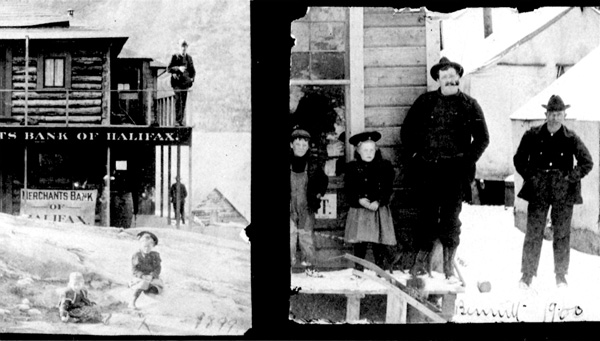
63 Bennett, 1900.
(Hazel Hartshorn [Gloslie].)
|
The hotel, the church's major contender as a social centre, was also
undergoing substantial change. In the spring of 1898 when Martha Black
passed through Bennett, she commented "there were two or three so-called
hotels, canvas roofed, wooden affairs, each of which had a kitchen,
dining room, bar and dance-hall in one room."2 These hotels
also provided sleeping place on the floor at night, and gambling was
certainly a preoccupation in some of them. Any traveller who wanted a
place to eat, drink, sleep, or meet his fellow man was forced to spend
some of his day there. As time passed, the hotel's role as hub was
gradually reduced. Mounted Police enforcement of a no-work Sunday
regulation assisted the division of functions.3 Before long,
respectable hotels which provided food and accommodation appeared, and
all other activities were relegated to a separate institution, the
saloon.4 As the saloon's entertainments could only be reached
by deliberate intention, participation in its activities often caused
moral indignation and by 1900 gamblers were even asked to leave town.
All of these things, of course, are signs that Bennett was forgetting it
was a northern boom town and adopting southern "civilization."
By 1899 when Sinclair began to build the church, the town was
thriving on what many thought would be a permanent base. After the
throngs of gold-seekers disappeared in 1898, Bennett became the
transshipment centre for goods moving to the gold-fields at Dawson and
Atlin (Fig. 64). Fleets of sternwheelers (Fig. 65) and scows (Fig. 66)
carried goods away from Bennett to their destinations. The goods arrived
in Bennett from the south in a variety of ways. They were carried over
the Chilkoot Pass on aerial tramways (Fig. 67) to Crater Lake where they
were put aboard crude carts on rails that took them to Bennett (Fig.
68). They came over the White Pass first in wagons on the Brackett Wagon
road that was completed to Bennett in 18995 (see Fig. 69),
then as far as possible by train as stages of the White Pass and Yukon
Railway were completed. Some of these companies headquartered in
Bennett: most of them had warehousing facilities there. As soon as the
railway reached the summit of the White Pass it became the preferred
route for passenger traffic (Figs. 70, 71).
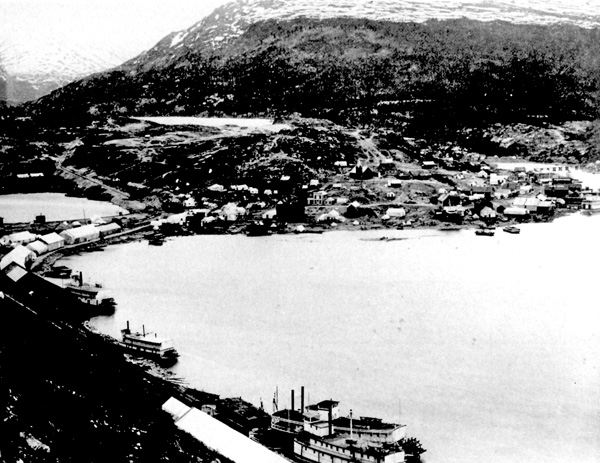
64 Bennett, 1900.
(Provincial Archives of British Columbia.)
|
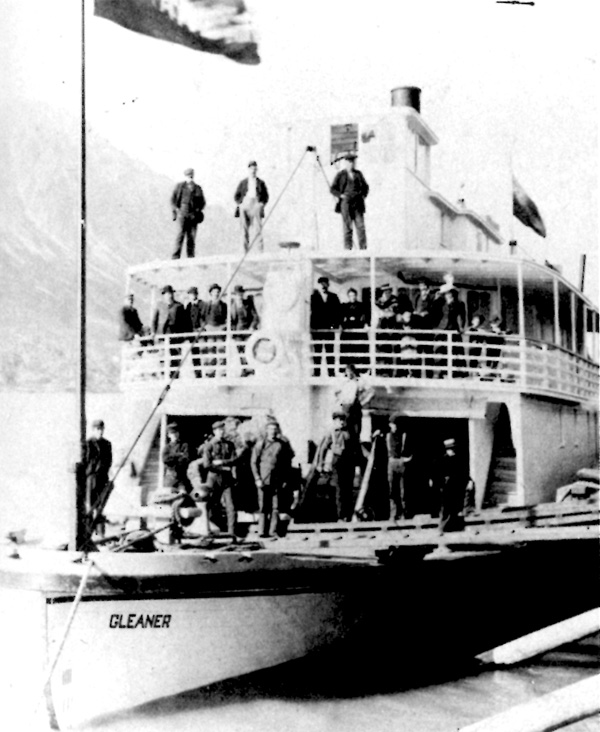
65 The Steamer Gleaner that ran from
Bennett to Atlin.
(Hazel Hartshorn [Gloslie].)
|
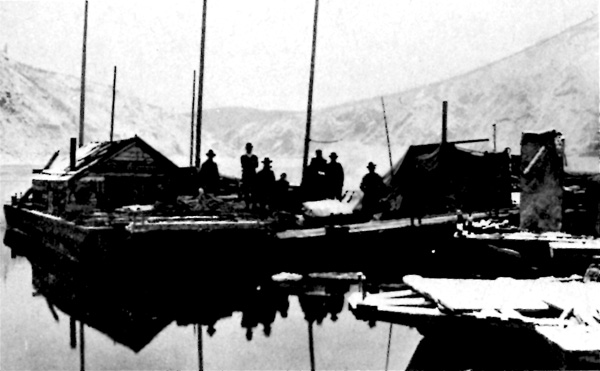
66 W. B. Copping's party arriving in Dawson,
October 17, 1900 with 5 scows and 100 tons of merchandise. These
goods were transshipped at Bennett.
(University of Washington.)
|
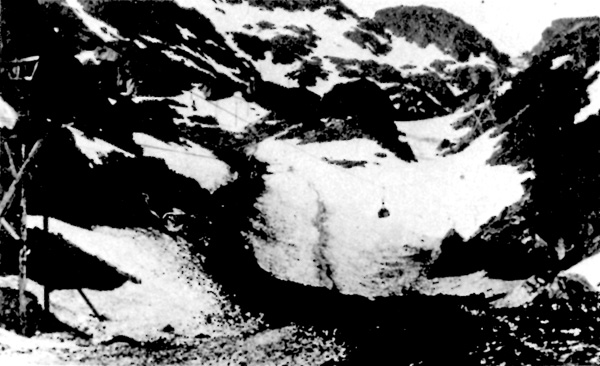
67 The aerial tramway that operated on the
Chilkoot Pass.
(Sinclair Papers.)
|
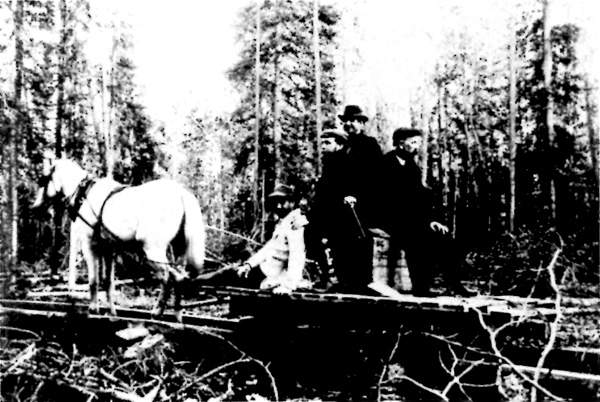
68 The cart that completd the tramway operation
between Crater Lake and Bennett before completion of the railway.
(Sinclair Papers.)
|
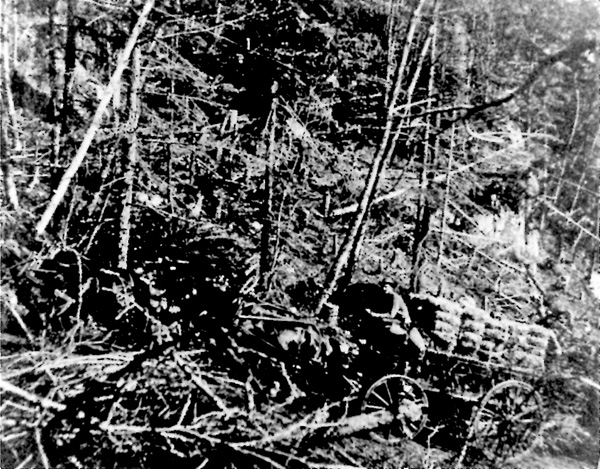
69 Freighting goods by waggon. This is probably one
of the Red Line waggons that operated out of Bennett.
(Sinclair Papers.)
|
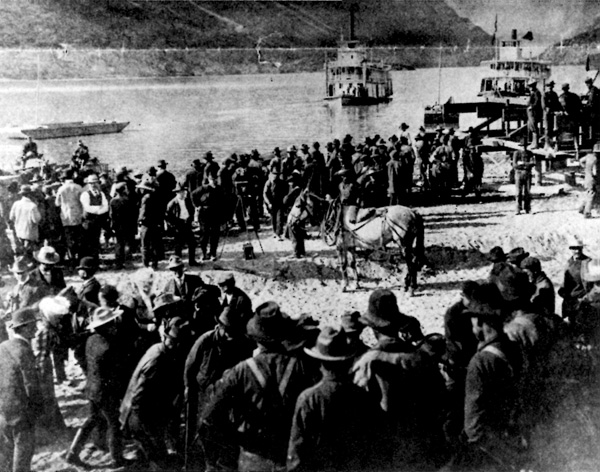
70 Driving the golden spike at Bennett, 6
July 1899.
(Sinclair Papers.)
|
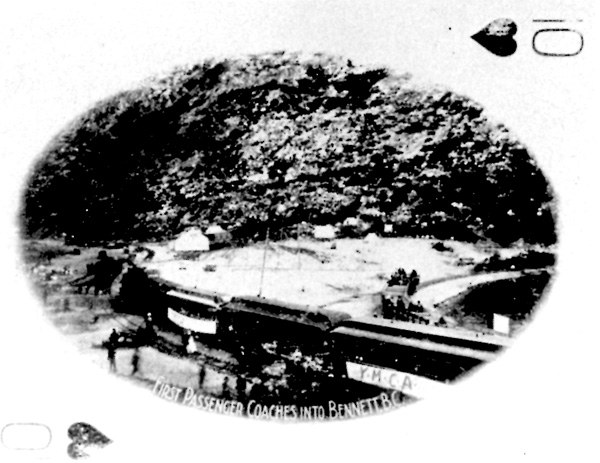
71 First passenger coaches into Bennett, B.C.
(Washington State University, Pullman.)
|
Passengers stayed in Bennett hotels, banked in
Bennett banks, and often they outfitted in Bennett stores. Employment in
these industries provided a constant reason for five to six hundred
people to remain in the town.6
Although there was a fairly high turnover in the
bodies that comprised this figure,7 between 1899 and 1900
most Bennett residents remained long enough for a sense of community to
develop. Concern for the industries that fed the town's prosperity was
common to all, and they took pride in noting the physical manifestations
of success. Every time a two-storey hotel sided with corrugated iron was
constructed (Fig. 72), the event was heralded in the pages of the town's
most enthusiastic booster, the Bennett Sun. The Sun also
delighted in recounting the shock new improvements caused men who had
not been to Bennett since 1898.8 St. Andrew's Church, Lake Bennett,
profited from this growing community spirit in the support and
encouragement it received, for the period of its construction capped the
height of Bennett's prosperity.
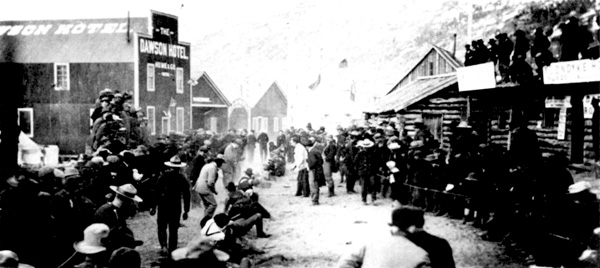
72 Tuf of War, 1900 — a sign of Benntt's new
community spirit. The Dawson Hotel and the warehouses in the distance
on the left are covered with corrugated iron.
(Sinclair Papers.)
|
In fact, the condition of the Presbyterian mission at Lake Bennett
parallels gold-rush developments at that centre closely. The mission was
established early in 1898 just before a throng of gold-hungry men
arrived to await spring breakup on their way north. At that time the
church building was temporary, a log shack similar to those used by
old-time northern miners. It was sufficient because the church received
so little support that it was all that was required. The few men it was
attempting to serve were preoccupied with their push north over the ice
in a single-minded drive to meet worldly ambitions. This attitude
moderated as more men were trapped in Bennett waiting for the spring
breakup of 1898. A proportion of such a large crowd of southern men
would inevitably be interested in the church, and this is reflected in
increased financial support and attendance at services. A canvas church
was constructed to accommodate them. After the Klondikers left, Bennett
itself hung in a limbo of little activity until the railroad reached the
summit of the White Pass and it became an easy matter to ship goods
north in quantity. During this period the Bennett missionary, Sinclair,
spent most of his time in Skagway and in the railway camps, devoting
little selective time to town. Such services as were held, took place in
Bennett's hotels on an irregular basis. Once Bennett began to fulfill a
major role in the territory's transportation network, however, the town
showed signs of becoming better established. It was then that Sinclair
built a permanent church with the assistance and approval of its
residents.
The close relationship that existed between the church and the town
of Bennett provides the inevitable explanation for the end of church
activity. As has already been indicated, by 1899 Bennett had become the
transshipment hub for goods moving north. During most of 1900 it thrived
on this role; however, late in that year the White Pass and Yukon
Railway was completed to Whitehorse. This event alone relocated the
transportation centre for the Yukon in Whitehorse, and along with it
went most of Bennett's population.9
The Reverend J.A. Sinclair participated in the exodus. As early as
1899 he had identified "Closeleigh," or Whitehorse, as a possible area
for development and had obtained a church lot there.10 Late
in 1900, when it became evident that some development would shift to
that point, he moved there to establish a church. At the time he left,
Sinclair felt "the future of Bennett is somewhat
problematical."11 Earlier he had speculated that the scow and
sailboat trade that operated from the town would keep it
alive.12 This trade quickly supplied the Dawson market with
fresh produce and filled its food shortages. Sinclair's predictions
might have come true if developments at Dawson had continued to expand,
and if railway rates had been high. As it was, not only were the rates
competitive, but mining in the Dawson area was mechanized and "the
Eldorado" stabilized at a population below that of 1900. This precluded
the demand for an extensive scow and sailboat trade.
This situation was not clear when the Reverend R. James Russell
arrived from Schreiber, Ontario, to take Sinclair's place in Bennett in
the fall of 1900. Russell continued church functions in Bennett until
1902 when the population had shrunk to a handful because there was no
employment. At this point he moved to take John Pringle's place in the
mining area at Atlin where his services were required.13 With
his move, the church was abandoned.
|

